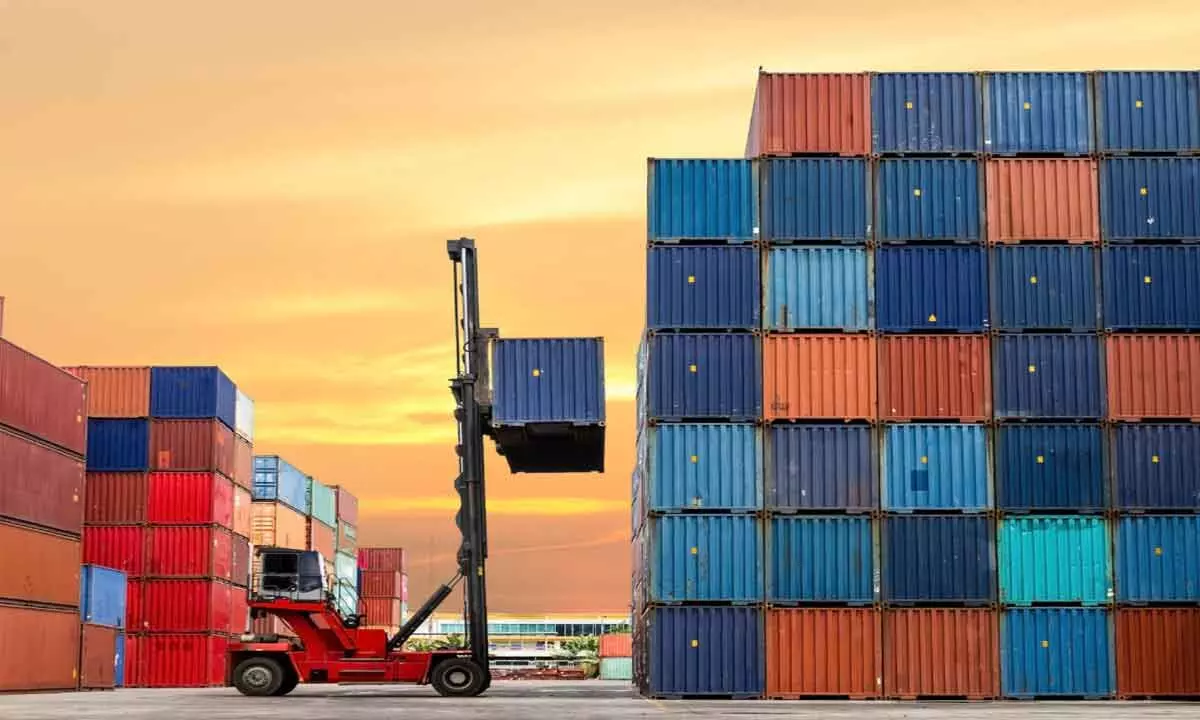Electronics, services exports to contain slide in growth rate
Despite global challenges, India’s exports and imports of goods and services are likely to dip by 2.6% to $1,609 bn in 2023 as against $1,651.9 bn in 2022: Report
image for illustrative purpose

Sectors Expected to Grow in Exports
• Aviation turbine fuels, motor gasoline, basmati rice, motor car-medium size, turbo-jets, auto components
• Smartphone exports expected to jump by about 93% to $14 bn during current calendar
• India’s case, the depreciation of the INR did not translate into increased export volumes
New Delhi: Robust exports performance in electronic goods, particularly smartphones, and services sectors will help India contain the fall in growth rate of overall trade, which is expected to decline by 2.6 per cent in the current year, a report said.
Economic think tank Global Trade Research Initiative (GTRI) in its report said that despite global challenges, India’s exports and imports of goods and services are likely to dip by 2.6 per cent to $1,609 billion in 2023 as against $1,651.9 billion in 2022. The decline in India’s merchandise exports mirrors the global trend of a 5 per cent decline (as per UNCTAD’s Global Trade Update) and aligns with China’s 5.2 per cent drop in merchandise exports during January-November 2023, it added. The World Trade Organization (WTO) has forecast that the global merchandise trade volume would grow only by 0.8 per cent in 2023.
In 2023, sectors which are expected to register growth include, aviation turbine fuels, motor gasoline, smartphones, basmati rice, motor car-medium size, turbo-jets, and auto components. Smartphone exports are expected to jump by about 93 per cent to $14 billion during the current calendar year as against $7.2 billion in 2022. “In 2023, smartphone will emerge as a major success story for India. This significant increase will contribute to the overall rise in India’s electronics exports, which reached $26.8 billion, marking a growth of 26.2 per cent,” it said, adding imports of electronic goods will grow by over 8 per cent to $81 billion.
Imports of finished electronic products like computers, laptops, and other hardware may decline by over 10 per cent this year. Exports of traditional sectors such as engineering goods, petroleum products, chemicals, gems and jewellery, readymade garments of all textiles, cotton yarn/fabrics/made-ups, handloom products, plastic, marine products, leather, carpets, handicraft, and tea are expected to fall in 2023. “The decline can be attributed to weak global demand and India gradually losing its competitiveness in labour intensive sectors,” GTRI Co-Founder Ajay Srivastava said adding exports of petroleum products may also fall by over 9 per cent to $ 86 billion. “Conversely, imports of petroleum crude are projected to rise to $139.8 billion in 2023, marking a 14.1 per cent increase over 2022,” he said. The report said that India’s merchandise exports may decline by 5.3 per cent to $429.4 billion in 2023 from $453.3 billion in 2022. Similarly, the imports could dip by 7 per cent to $670 billion this year as against $720.2 billion in 2022. Services exports, on the other hand, are expected to rise by 10.5 per cent to $333.5 billion in 2023 as against $302 billion in 2022. Imports however may record a flat growth at $176.4 billion in 2023. “Exports of goods and services are expected to slightly increase to $763 billion in 2023 from $755.3 billion in 2022. Imports, however, may dip by 5.7 per cent to $845.8 billion in 2023 from $896.6 billion in 2022. Consequently, the total value of exports and imports together could be reduced by 2.6 per cent, from $1,651.9 billion in 2022 to $1,608.8 billion in 2023,” the report said. It added that gold imports may increase by over 18 per cent to $43.33 billion this year.
“Interestingly, this decrease in exports occurred despite a considerable depreciation in the Indian Rupee (INR) against the US Dollar (USD). Over the span of one year, the average INR/USD exchange rate had depreciated from 77.5 in June 2022 to 82.1 in June 2023,” Srivastava said. He added that normally, a weaker domestic currency can boost exports by making a country’s products more competitive in the global market. “However, in India’s case, the depreciation of the INR did not translate into increased export volumes,” he said.

